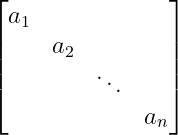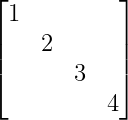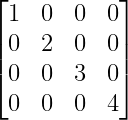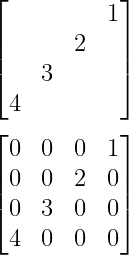A diagonal matrix is a special type of square matrix where all the elements outside the main diagonal are zero. The only nonzero elements appear along the main diagonal (from the top left to the bottom right).
\documentclass{article}
\usepackage{amsmath}
\begin{document}
\[ \begin{bmatrix}
a_{1} & & & \\
& a_{2} & & \\
& & \ddots & \\
& & & a_{3}
\end{bmatrix} \]
\end{document}Output :
Using the physics package for diagonal matrices
The physics package in LaTeX provides convenient commands to represent diagonal matrices in multiple ways.
\documentclass{article}
\usepackage{physics}
\begin{document}
\[ \mqty[ a_{1} & 0 & 0\\ 0 & a_{2} & 0\\ 0 & 0 & a_{3} ] \]
\end{document}Output :
Second, you can use the \dmat command. However, this \dmat command must be passed as an argument in the \mqty command without using direct.
\documentclass{article}
\usepackage{physics}
\begin{document}
\[ \mqty[\dmat{1,2,3,4}] \]
\end{document}Output :
With that, the elements of the diagonal matrix have to be passed into \dmat command.
To fill in any position other than the diagonal position of the matrix by zero, you need to pass zero in the optional argument with \dmat command.
\documentclass{article}
\usepackage{physics}
\begin{document}
\[ \mqty[\dmat[0]{1,2,3,4}] \]
\end{document}Output :
Inverse diagonal matrix
If you want to arrange the elements of the matrix along the inverse diagonal you need to use \admat command instead of \dmat command.
\documentclass{article}
\usepackage{physics}
\begin{document}
\[ \mqty[\admat{1,2,3,4}] \]
\[ \mqty[\admat[0]{1,2,3,4}] \]
\end{document}Output :




